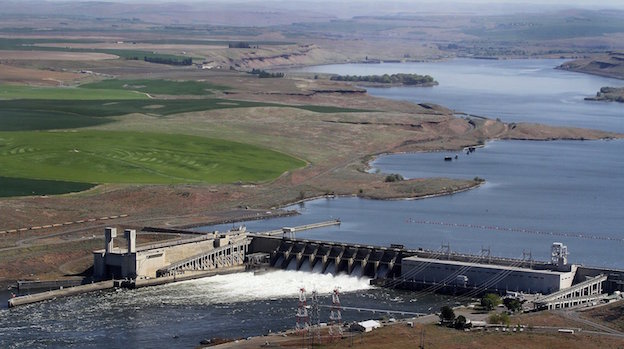forum
library
tutorial
contact

Restaurants are Worried About Salmon.
But is Breaching Snake River Dams the Solution?
by Annette Cary
Tri-City Herald, March 18, 2022
|
the film forum library tutorial contact |

|
Restaurants are Worried About Salmon.
by Annette Cary
|
Northwest RiverPartners' goal this year is to provide context to the public
for the lower Snake River Dam issue.
 KENNEWICK -- The latest debate on tearing out the lower Snake River Dams has landed on the fine dining tables across the state of Washington.
KENNEWICK -- The latest debate on tearing out the lower Snake River Dams has landed on the fine dining tables across the state of Washington.
Some 225 chefs, restaurateurs, brewers, winemakers, market owners, commercial fishermen and other food professionals are urging Gov. Jay Inslee and Washington's U.S. Sens. Patty Murray and Maria Cantwell to continue work to come up with an investment package to allow breaching the Eastern Washington dams.
Most of those who signed a letter sent to the three Democratic leaders last week are based in Western Washington.
But about 10% are from Eastern Washington professionals, including in Prosser, Walla Walla and Yakima.
The availability of salmon in the Pacific Northwest impacts the bottom line of their businesses and helps them maintain jobs for employees and provide healthy food for customers, said the letter.
The intent of the people who signed it is good, said Kurt Miller, executive director of Northwest RiverPartners, which represents Northwest electric utilities, plus river transportation and agriculture interests.
But, "from our perspective if they really understood that climate change and especially the warming, acidifying ocean is the main risk to all salmon populations, would they still sign a letter like that?" he asked.
Of the 76 threatened, endangered and at-risk salmon and steelhead populations along the U.S. and Canadian Pacific Coast, 72 are not connected to the lower Snake River, he said.
"All 76 are threatened by climate change," and getting rid of the carbon-free electricity generation of the Snake River dams would not help that, he said.
Murray and Inslee have not committed to a plan to remove the four lower Snake River Dams from Ice Harbor Dam near the Tri-Cities upriver to Lower Granite Dam near Lewiston, Idaho.
But they want planning finished by July 31 on how the Northwest could replace the clean energy, irrigation, agriculture and transportation the dams now make possible.
"We need new policies and programs in 2022 that will provide both fisherman and farmer greater certainty and the opportunity to thrive," the letter from food professionals said.
"We ask you to seize the window of opportunity before us to develop and deliver a comprehensive investment package that restores the lower Snake River, recovers healthy salmon populations, and keeps farmers and fishermen gainfully employed and feeding our communities," it said.
Breaching dams studied
A $40 million environmental study completed by federal agencies in 2020 concluded that breaching the dams was not in the best interest of society from the perspective of climate, costs and societal benefits, especially given the uncertainty of the magnitude of benefits for salmon.
Instead, the decision was made to spill more water over dams each spring in the Columbia River hydrosystem, which includes Snake River dams, to help juvenile fish heading downstream.
Now, the Murray and Inslee process is following the scientific study by interviewing organizations and people about what steps should to be taken should the dams be removed.
The outcome of their process will be influenced by who is interviewed, how many people are interviewed and how much weight is given to different information and opinions collected, Miller said.
"All that is really subjective and potentially really political," Miller said. "And that's a lot different than a true scientific study."
For people in the Puget Sound, it may sound easy to solve the problem of endangered salmon populations by removing four dams that are far away from them.
"But those people probably don't know what hardships that losing those dams would bring to the entire region -- certainly to Eastern Washington, but really to the whole region," Miller said.
Education on dam benefits
One of Northwest RiverPartners' goals this year is to provide context to the public for the lower Snake River Dam issue.
Many groups looking at endangered salmon are narrowly focused on the dams and missing the bigger picture of climate change, decarbonizing the electric grid, the widespread decline of salmon populations all along the West Coast and the impact that losing the dams would have on vulnerable populations, Miller said.
Among the key benefits of the dams are providing two-thirds of Washington's electricity generation that is completely carbon free, according to the Tri-City Development Council.
They also provide the steady power backup needed to incorporate intermittent solar and wind energy onto the grid.
Replacing the hydroelectric dams with natural gas plants would add 3 million metric tons of carbon per year to the atmosphere, say supporters of keeping the lower Snake dams.
Replacing them with wind, solar and battery storage would cost $1 billion and cause the electricity bills for the region to jump by 50% annually.
Shipping by barge also reduces carbon emissions that would be created by moving grain and other commodities by train or truck.
Now the Columbia and Snake waterway is the nation's largest wheat export gateway and the third-largest grain gateway in the world, with more than half of the wheat passing through at least one Snake River dam.
Without the dams, each four-barge tow traveling on the Snake River would have to be replaced by 140 rail cars or 538 trucks, according to shippers.
Related Pages:
We Can Have Our Salmon and Eat It, Too by Walt Pollock, The Register-Guard, 9/2/21
learn more on topics covered in the film
see the video
read the script
learn the songs
discussion forum
